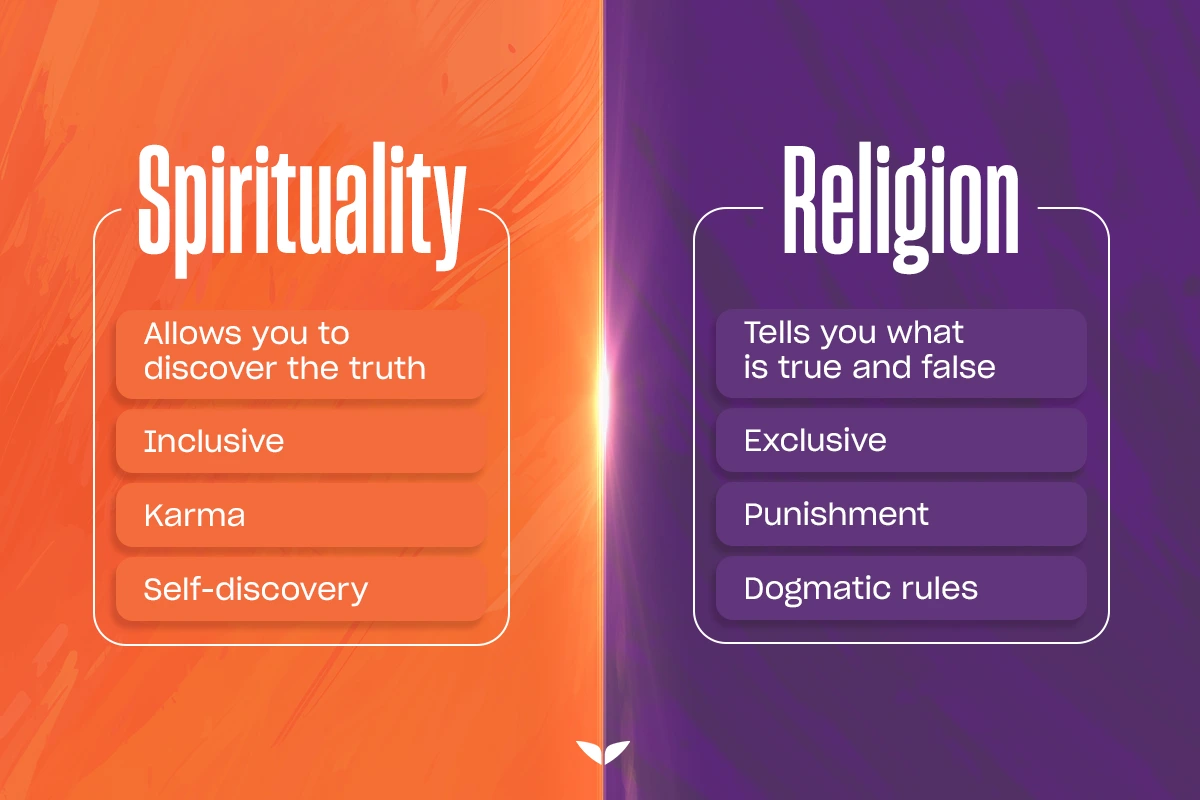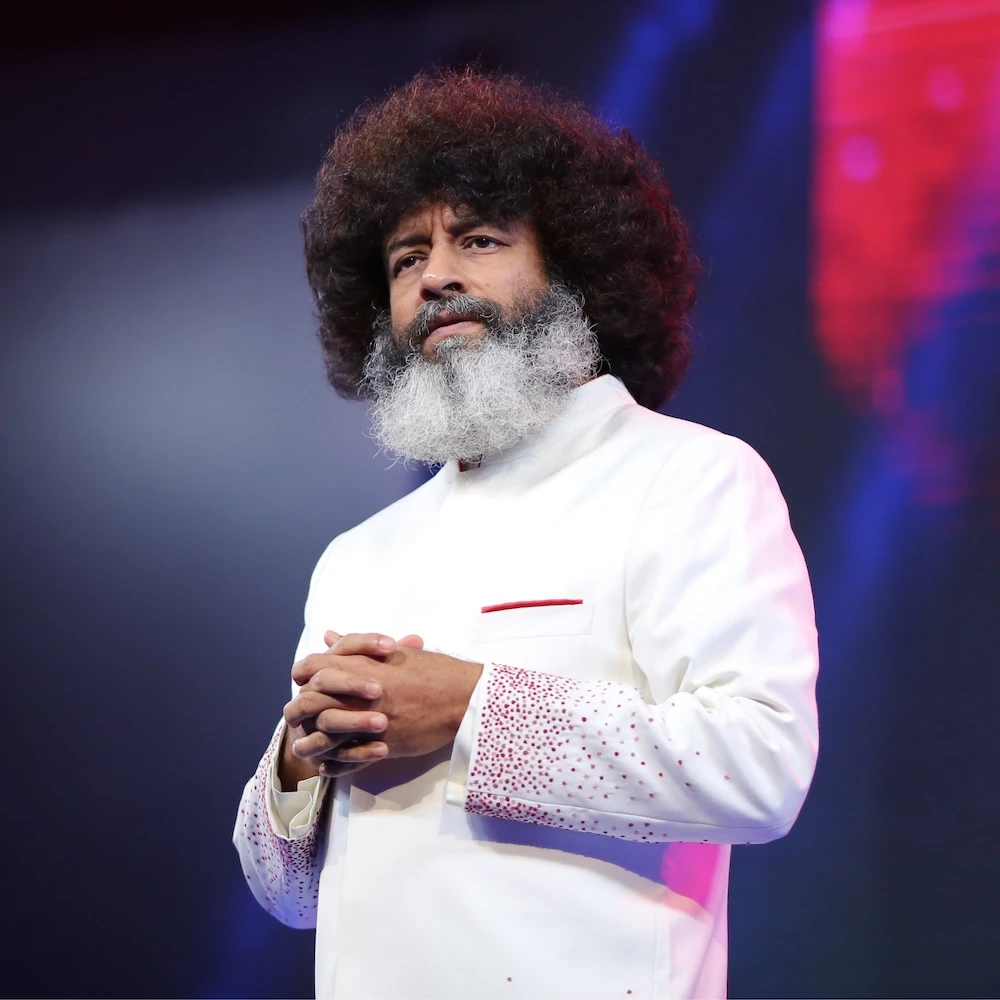Spirituality vs. religion? Telling people you are spiritual but not religious is often greeted with a confused face.
People tend to think of spirituality as something very strange and mysterious. They even struggle to differentiate it from religion. But this is only because there’s a common fear of diving deeper into the unknown of non-material subjects.
Therefore, people might believe this spiritual belief system is just another tendency to manipulate and separate opinions.
The truth is that spirituality is perhaps the most natural thing there is—it is simply your conscious self recognizing that you are more than just a body and that you are a soul with infinite potential.
Spirituality vs. religion: 6 key differences
“What is the difference between religion and spirituality?” you might ask. Simply put, spirituality has no rules, whereas religion is wholly based upon pre-established beliefs and practices, rituals, and dogma.

When someone is spiritual, they have a connection with themselves and life on a soul level. And ‘God’ isn’t an external force like in most religions.
Oftentimes, there’s confusion when it comes to spirituality vs. religion. According to this 2019 study, spirituality and religion have positive influences on one’s well-being, but they aren’t the same thing.
So what are the key aspects that differentiate between the two? Here are six points to understand:
1. There are no rules to spirituality
As opposed to following a specific ideology or a set of rules, spirituality simply lets you follow your heart. It encourages you to listen to your intuition as well as do what is right for yourself and others around you.
It sets you free to be the best you can be, with no promise of punishment or reward. The reward is simply your inner happiness.
When the pressure of having to be good so that God ‘likes’ you is taken off your shoulders, you’ll notice how it becomes simply natural. You won’t think of what needs to be done, but you will rather act involuntarily by the grace of your core being.
We all come on this earth with the innate kindness of our hearts. And sometimes we just need to discover how to connect to this purity once again, as it has never left our being.
2. Spirituality is based only on love and not fear
Dotted throughout religion, there is a lot of fear regarding the consequences of your actions. You become afraid of what might happen after you die if you don’t live your life accordingly.
With spirituality, there is only love. It encourages you to focus all of your energy on the good while acting from this place. As the saying goes, love is always in the air, right?
Any choice made out of fear may not be good for your spirit. Whereas decisions made out of love will empower you, make you braver, and feed your soul.
It shows you how to push through despite being afraid and how to move on doing what you feel is right despite the consequences that may come.
3. Religion tells you the truth, spirituality allows you to discover it
As opposed to telling you in black-and-white how the universe was created and why we are here, spirituality lets you discover these questions and answers for yourself.
It empowers you to find your own truth in all things and sets no limits to how deep you can go in understanding all there is to know. The more you know, the more you’ll realize you don’t know anything.
Spirituality shows you how to find beauty in observing the way we cluelessly swim in the vast ocean called life. This is where true spiritual awakening happens. And you won’t miss the signs of it.
4. Religion separates, spirituality unites
In our world, there are many religions, and they all preach that their story is the right story.
Spirituality sees the truth in all of them and strives for unity because the truth is the same for all of us, despite our differences.
It focuses on the quality of the divine message they share and not on the differences in the details of the story they speak.
When we analyze them bit by bit, we’ll notice common patterns and ideologies in most religions in the world. The truth is only one, and it can take different forms, but its essence will always remain unshakable.
5. The difference between karma and punishment
Instead of talking about punishment or the threat of hell, spirituality only talks about karma.
It’s linked to the Law of Attraction—you get what you give. Simple.
Karma can easily be described as the consequences of our actions in this existence or previous ones. Some may refer to it as good or bad luck, but in reality, it only represents the action and reaction mechanisms of the universe.
By introducing the concept of karma, spirituality teaches us to take full responsibility for our lives and act mainly with intention. The good ones.
6. Walk your path
Instead of ancient stories about angels and gods, spirituality encourages you to make your own path and create your own stories. This sets you on a journey of enlightenment and self-discovery on which the only limits can be set by yourself.
It encourages you to trust your heart and follow it wherever it may lead you.
If you look at religion, it all stems from a deep spirituality. Jesus and Prophet Mohammed, for example, all had deeply profound spiritual journeys.
Their paths inspired others around them so genuinely that they created religious dogmas based on these masters’ spiritual discoveries.
Spiritual vs. religious people: What is the difference?
The difference between a spiritual and religious person comes down to how they see God.
For a religious person, the concept of God is predetermined, named, and comes with a set method on how to worship that God. A spiritual person, on the other hand, turns inwards to find their truth and find God within themselves and all of life.
The whole shebang regarding tuning into your spiritual self is that suddenly, life becomes about being, not about doing. You learn to be more of who you are, and this is going to be rewarded by your external reality.
The beauty of it comes down to the fact that you don’t have to strive for the perfect ‘destination’. You’ll just learn to realize that you’re already there. The destination people are unconsciously trying to reach is their truest selves.
Your soul doesn’t care what you do for a living and when your life is over, neither will you. Your soul cares only about what you are being while you are doing whatever you are doing.
— Neale Donald Walsch, trainer of Mindvalley’s Awaken the Species Quest
Learn more about connecting to your spirituality: Mindvalley’s Top 4 Free Spiritual Growth Classes.

Let yourself be guided
The world we live in has got us to believe that religion vs. spirituality should be an ongoing debate.
However, when we approach life with acceptance and openness, we’ll see that both have pure intentions at their very core. Both open up a world of possibilities where we can be guided by a life force bigger than ourselves.
As we live, we learn more about the way we can create our dream reality when we focus on spiritual well-being. This knowledge is the key to mastering peace and harmony in your life.
There is no such thing as ‘getting to heaven’. There is only a knowing that you are already there. The irony is that most people think they have to leave where they are to get to where they want to be.
— Neale Donald Walsch, trainer of Mindvalley’s Awaken the Species Quest
If you’re ready to embark on your spiritual evolution journey, you came to the right place. Mindvalley opens up the door to your path with the Awaken the Species program. By signing up to Mindvalley for free you can watch a free class, alongside a few selected meditations to help you on your spiritual journey.
Step into your greatness and learn how to transform your life from the inside out today.
—
This article was originally published in Life Coach Code, written by Dejan Davchevski. It was then updated by the Mindvalley team on June 21st, 2022.









